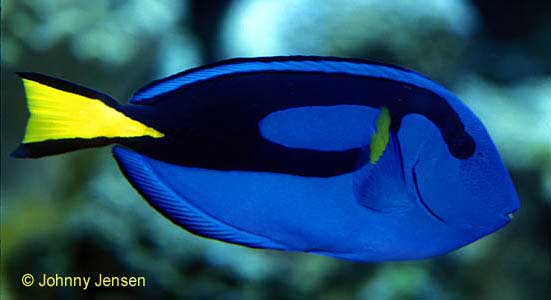|
|
Regal Blue Tang

The Regal Tang is known by a long list of alternate names, including the Blue Tang, Pacific Blue Tang, Palette Tang,
Blue Hippo Tang, Wedgetail Blue Tang, Hepatus Tang, Blue Surgeonfish and the Yellow Tailed Blue Tang.
When referred to as the Blue Tang
it can be confused with the Caribbean Blue Tang
(Acanthurus coeruleus), which explains why it is often referred to as the Pacific Blue Tang. The Regal
Tang was popularized by the movie Finding Nemo, in which the character Dory was a Regal Tang. The
name "tang" is derived from German and refers to their predisposition toward seaweed.
The Regal Tang is a member of the surgeonfish family. The surgeon name refers to two sharp spines
that stick out at the caudal peduncle - the area where the tail joins the rest of the body. The spines
are easily tangled in nets. Regals will use these spines to wedge themselves into coral, so don't injure
them by panicking and trying to remove them. The mouth on tangs is very small and the body is compressed
laterally. The
Regal's body is a beautiful blue oval with a black swirl that is reminiscent of an
artist's palette. The caudal fin is yellow with a black edge along the margins.
Regals occur naturally in the western Pacific. They are common throughout the Great Barrier Reef of
Autstralia. The Philippines
and Indonesia are common areas to catch these fish.
Regal Tangs are not a great choice for beginners, although they are one of the most popular fish for
aquariums. The Regal is susceptible to parasitic diseases and also suffers if their diet is inadequate.
Among the most common
diseases are saltwater ich, velvet, hole in the head disease and head & lateral line erosion.
A well rounded shape is an indication of a healthy Regal Tang.
Regals prefer very clear turbulent water with a high oxygen content. A protein skimmer is
essential and an extra pump for circulation is recommended. A minimum tank size of 80 gallons
is recommended. Several can be kept in a 100 gallon tank. Allow for hiding places, as they are
accustomed to hiding among coral branches.

Regals are omnivorous. They use their beak-like mouth to consume zooplankton and scrape algae
in the wild. Their aquarium diet should include Mysis shrimp, dried
seaweed (nori), freeze dried brine shrimp, freeze-dried plankton, flake foods, chopped capelin,
chopped squid, broccoli, peas and leafy greens. Some recommend against adding vegetable matter
due to the risk of changing the water quality by introducing acids, nitrates and pesticides.
Julian Sprungs Sea Veggies, Ocean Nutrition Seaweed Selects and standard
spirulina flakes are all excellent choices. Most invertebrates will be ignored, but some cleaner
shrimp have lost their antennae to Regals. For Regals that won't eat, try live brine shrimp rinsed
in fresh water. Feeding as continuously as you can is the best approach. Poor nutrition is a major
reason for losses.
The Regal is compatible with other tangs, but males will be aggressive with other Regal males in
the same tank. In the mating season, which is normally February and March, a male will mate with
and control a group of females. The males are slightly larger than females. Regals are egg-scatterers,
but they have not been successfully bred in captivity.
Quarantining your new Regal may not a good idea, as the stress of a further transfer is hard on them.
Buy a specimen that is alert, doesn't look thin and is over 3 inches long. If your Regal has a nutritious
diet and clean, clear water, it
will live for many years.

juveniles
| Scientific Name: |
Paracanthurus hepatus |
| Family: |
Acanthuridae |
| Care: |
Normal |
| Temperature: |
22 - 26 C; 72 - 78 F |
| pH: |
8.0 - 8.4 |
| dH: |
8 - 12 |
| Specific Gravity: |
1.020 - 1.025 |
| Size: |
31 cm; 12 inches |
| Breeding: |
Egg Layer |
| Life Span: |
20 years |
| Crustacean Safe: |
Attacks small ones |
| Coral Safe: |
Yes |
|
Compatibility:
|
|
Female regal tangs, yellow tangs, clownfish,
damsels, small angels (Centropyge), cardinalfish,
hawkfish
|
|